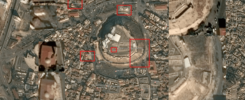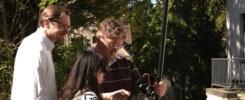In April 2025, the German Archaeological Institute (DAI), with the support of the German Federal Agency for Technical Relief (THW)and the Leibniz Center for Archaeology (LEIZA) organized an online workshop entitled “Yesterday-today-tomorrow: where does the protection of cultural heritage stand in 2030?”
Organised in the framework of the European project PROCULTHER-NET2, this workshop was based on a format used in 2020 to organise the first working groups bringing together cultural heritage and civil protection experts in Germany around the KulturGutRetter project. Five years after these meetings, the aim was to convene both sectors again, including former and new participants, to reflect on past achievements, report on current developments, and think together about future perspectives to improve collaboration, preparedness and response capacities for cultural heritage in crises. Over 40 participants were present on each day of the workshop, with a total of over 50 participants coming from the civil protection sector and the cultural heritage sector.
Day 1, April 10, 2025
The first day opened with three presentations to set the global frame of the workshop.
Giovanni de Siervo, Project Director, International Relations and Activities Unit – Italian Civil Protection Department, introduced the European dimension of cultural heritage protection, especially focusing on the PROCULTHER approach, which has been developed through several projects. The need for a common understanding and minimum standards was stressed, as well as the way cultural heritage protection fits into the European Union Preparedness Strategy. Participants were invited to consult and contribute to the knowledge sharing tools developed by PROCULTHER-NET2, such as the “Key Elements of a European Methodology to address the Protection of Cultural Heritage during Emergencies” and the Technical Bulletins (#1, #2, #3, #4).
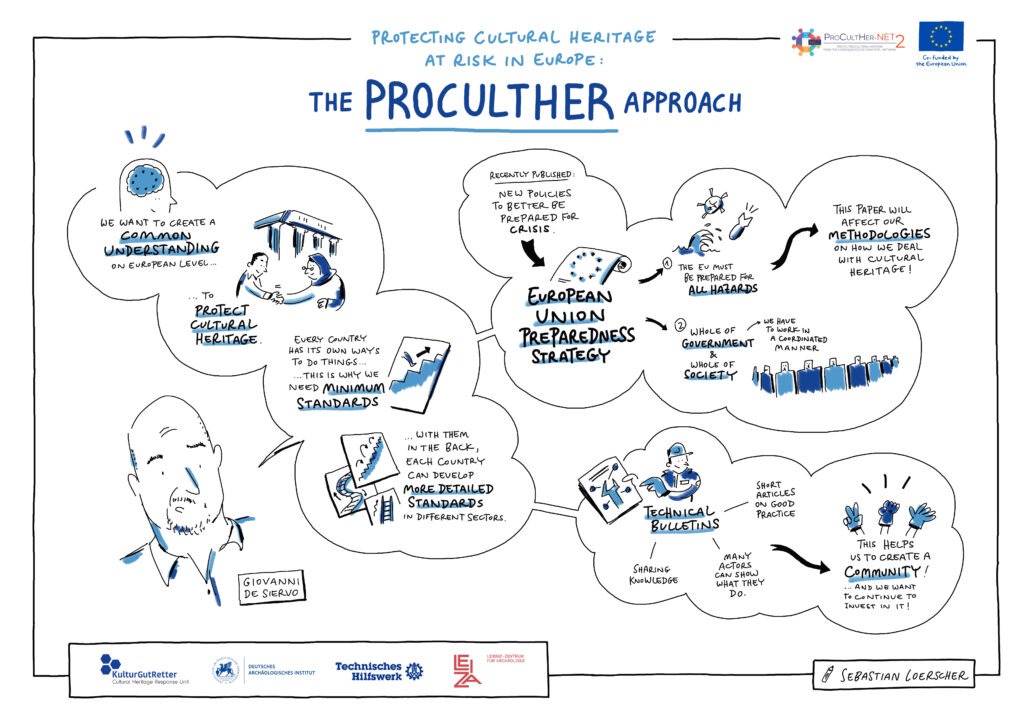
The next presentation was given jointly by Tobias Busen (German Archaeological Institute) and Alicia Rehberger (Federal Agency for Technical Relief), representing the two German Consortium Partners in PROCULTHER-NET2. Their input focused on the latest developments of the KulturGutRetter project in which, jointly with LEIZA, they develop the Cultural Heritage Response Unit (CHRU) to be deployed worldwide to protect movable ad immovable cultural heritage after a disaster caused by natural or human-related hazards. This includes training and exercises for the newly recruited volunteers (online curriculum, full-scale exercise in Germany, participation to the EU-MODEX in Venice…), fine-tuning of specialised equipment (mobile emergency conservation lab, damage assessment tools for immovable heritage, IT and software for documentation) and the development of Standard Operating Procedures.
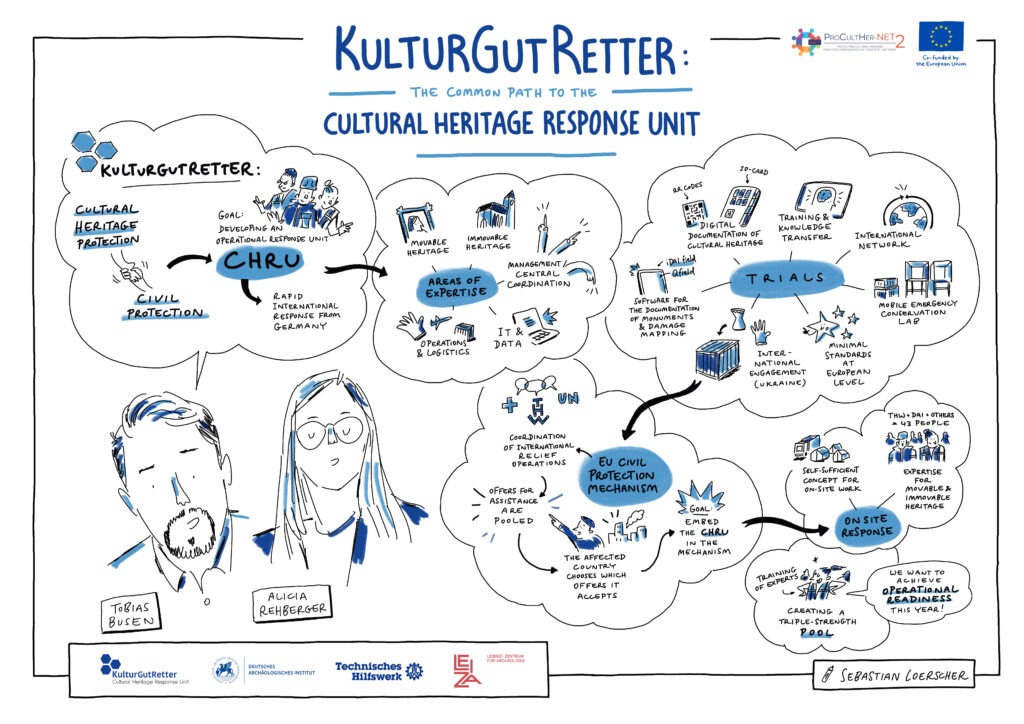
The third and last presentation of the first day was given by Christian Dolf, Commissioner for the Protection of Cultural Property under the Hague Convention – Federal Office for Civil Protection (BBK). He underlined the role of the BBK in protecting cultural heritage through civil protection and civil defence. Cultural heritage in Germany is being identified and marked, while also being documented on microfilm since 1975. Among the current developments are the documenting of intangible heritage on microfilms, the organisation of national exercises, and research and training on heritage protection.
A short Q&A session was the open for the participants to react on the three presentations and to exchange with the speakers.
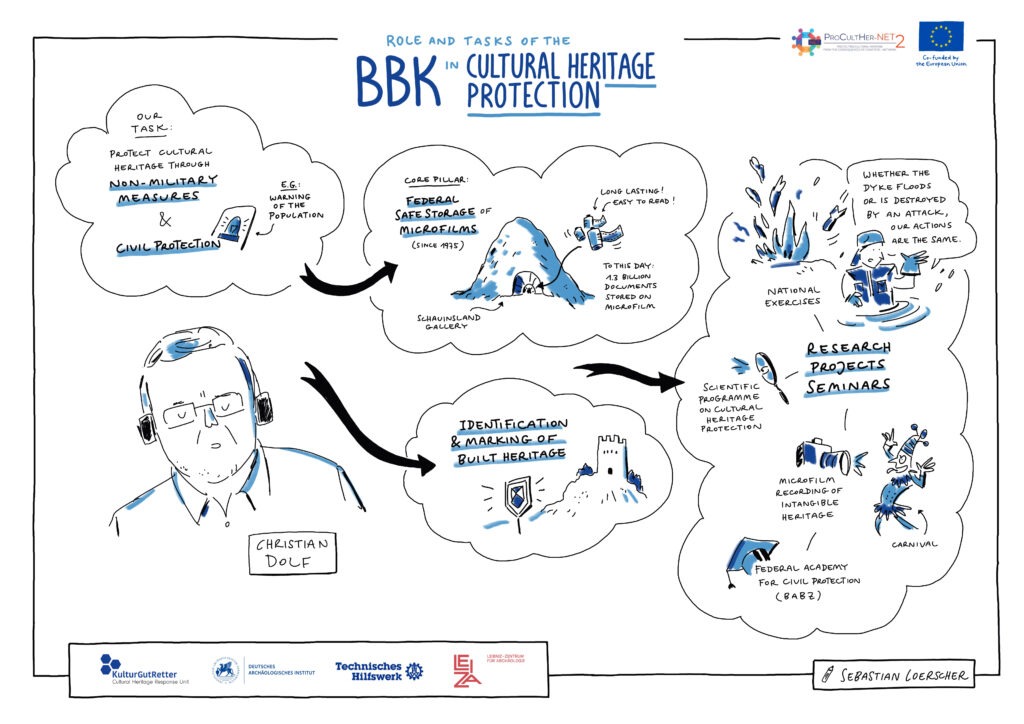
The participants were then split into three thematic working groups, according to their expertise: Movable Heritage, Immovable Heritage, IT & Data. The groups were facilitated by members of the organisers’ team. The goal was to identify best practices, gaps, and possible ways forward.
– Group 1 – “Movable Heritage” discussed emergency plans, minimal standards, the role of “emergency groups” in organising common training, and the inclusion of non-specialist personnel and neighbours.
– Group 2 – “Immovable Heritage” discussed the pros and cons of rapid damage assessment using paper or digital forms, and underlined the need to include more exchange opportunities in Germany’s federal structure (such as the portal Notfallverbuende.de)
– Group 3 – “IT & Data” discussed the compatibility of databases and the need to reach minimal international standards to facilitate the exchange and reuse of the collected data.
Day 2, April 11, 2025
The second day followed the same format. The first presentation was given by Almut Siegel and Alke Dohrmann, Project Leaders of SiLK, on the Cooperation of Emergency Alliances with ‘blue light’ organisations. A survey was sent to the network of Emergency Alliances in Germany to better understand how they worked with civil protection organisations. The firefighters were the first in line, although systematic site visits and sharing of the emergency plans are still lacking. The police, the army, and the Federal Agency for Disaster Relief (THW) were also mentioned. Some best practices were then put forward: the emergency container in Cologne, standardized equipment in Thüringen, regular round tables in Berlin…
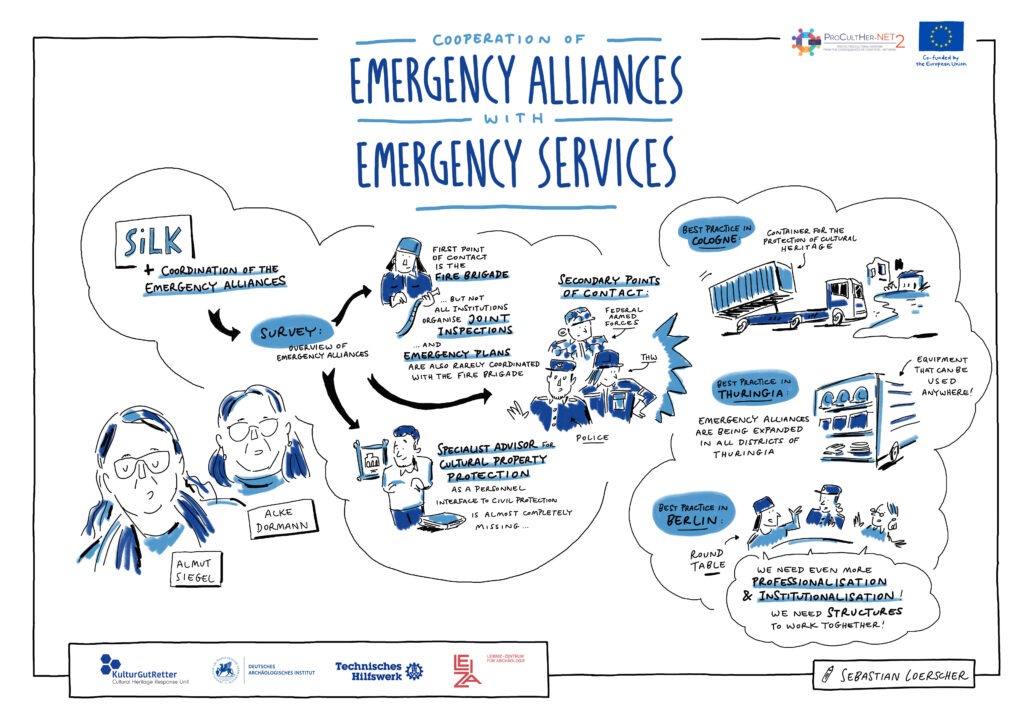
The second presentation showcased the common topics, standards, and planning developed by the Leibniz Association. Peter Giere, from the Museum of Natural History and Spokesperson for emergency planning in the network of conservators at Leibniz research museums, explained how standards are being strengthened by annual evaluations and interdisciplinary research. A working group dedicated to emergency planning brings together the 8 Leibniz research museums to work on minimal standard procedures, to test the compatibility of the systems (for example, between the Emergency Alliances and KulturGutRetter), and to share know-how with other projects. LEIZA, one of the Leibniz research museums, is thus one of the three project partners of KulturGutRetter.
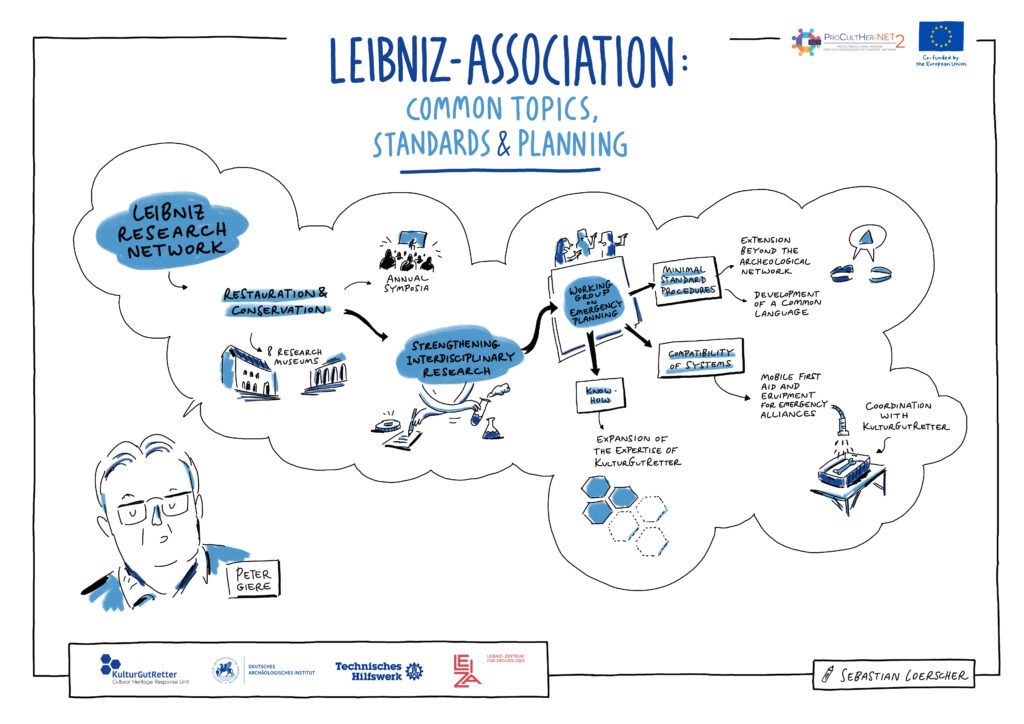
The last presentation focused on the recently published „Cultural Property Manual“, edited by the Association of Conservators (VdR). Nadine Thiel, Head of Conservation at the Historical Archive of Cologne and Member of the Presidium of the VdR. The Manual was designed to be practical and easy to use, especially in case of emergency. It details the basic measures to be taken in the preparedness phase, during the emergency and recovery.
A Q&A session followed the presentations.
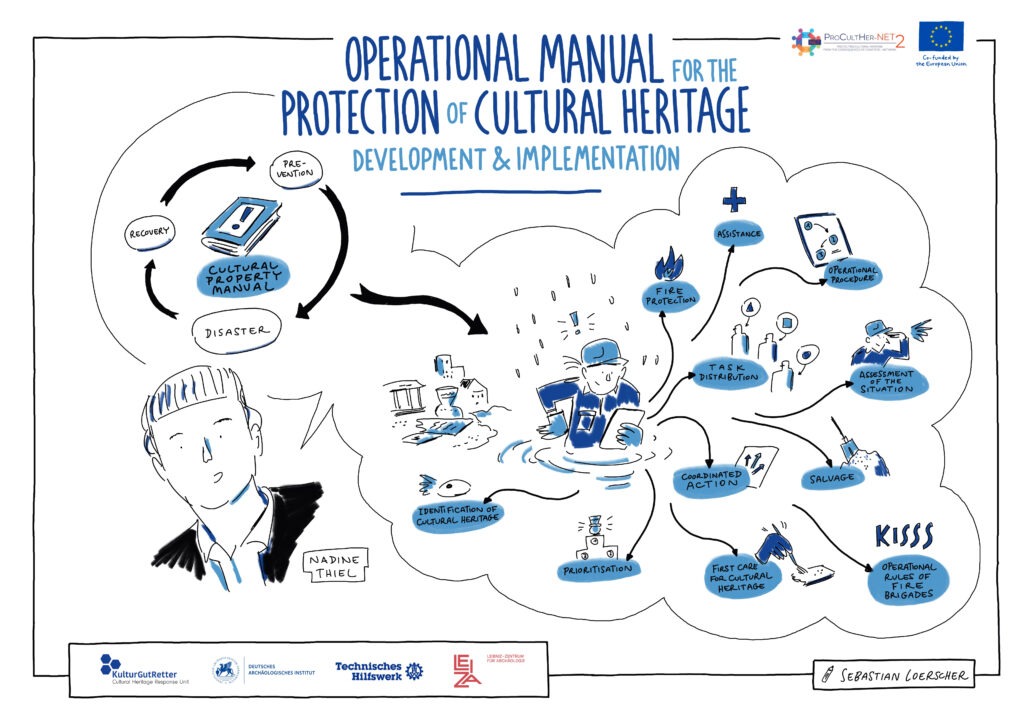
The last session of the workshop was dedicated to working groups focusing on cross-section topics:
– Group 4 – “Training and practice” discussed how to better embed cultural heritage protection in university curriculum, by training the professors, raising awareness among students, and developing courses. Several teaching formats, such as hands-on, theory, and e-learning, should co-exist, along with regular online events, series of talks, and summer schools. The goal is also to improve links between disciplines: archaeology, restoration, architecture, art history…
– Group 5 – “Deployment prerequisites and knowledge transfer” explored subjects as the ethical principles that should guide a response mission, especially when intervening abroad. The question of how to manage spontaneous donations was also mentioned and illustrated by examples from Notre-Dame and the floods in Ahrtal in 2021.
– Group 6 – “Engagement and spontaneous helpers” focused on the on-boarding procedures for the necessary volunteers that will offer their support during a response mission. This concerns quick training measures but also questions of housing/catering, personal safety equipment and psychosocial follow-up and support after the mission.
These two half-days of exchange contributed to strengthening the German national network, sharing good practice and identifying subjects on which collaboration between civil protection and heritage experts must continue.

